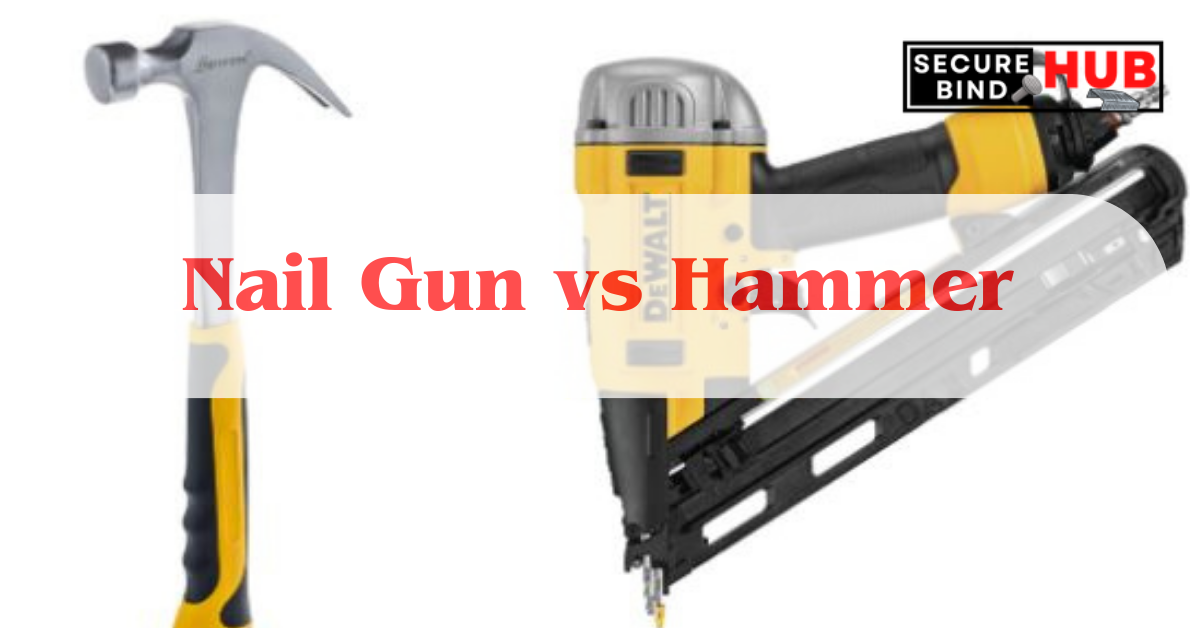When it comes to woodworking, construction, and DIY projects, the age-old debate of “Nail Gun vs Hammer” still remains relevant. Both tools have their unique advantages and disadvantages, and choosing between them depends on the specific task at hand. In this comprehensive guide, we’ll delve into the details of both nail guns and hammers, exploring their differences, applications, and the scenarios where one might be more suitable than the other.
Nail Gun vs Hammer: A Closer Look

To truly understand the nuances of this debate, it’s essential to dissect the characteristics and applications of both tools. Nail guns, a modern innovation, offer speed and precision, while hammers, the traditional choice, provide control and versatility.
Nail Gun: Power and Efficiency
Nail guns have revolutionized the construction industry by significantly speeding up the fastening process. With automatic nail feeding and rapid firing, they’re perfect for large-scale projects, such as framing and decking. The consistent driving force ensures nails are inserted precisely and without bending, resulting in a sturdy and reliable hold.
Hammer: Classic Versatility
On the other hand, hammers have stood the test of time for their flexibility and control. They allow for adjustments on-the-fly, making them ideal for delicate tasks like trim work and finishing touches. The tactile feedback from every strike empowers craftsmen to gauge the force needed, preventing overdriving or damaging materials.
Pros and Cons of Nail Guns
Nail guns come with a set of advantages and disadvantages that suit different project requirements.
Pros:
- Speed: Nail guns are lightning-fast, driving nails with remarkable speed, which is especially advantageous for time-sensitive projects.
- Precision: The consistent force applied by nail guns ensures nails are driven accurately and uniformly.
- Reduced Fatigue: Using a nail gun significantly reduces user fatigue during extended projects.
Cons:
- Cost: Nail guns can be expensive, making them an investment for DIY enthusiasts or occasional users.
- Learning Curve: Operating a nail gun effectively requires practice and familiarity to avoid mistakes and accidents.
- Limited Maneuverability: Some nail guns are bulky, restricting access to tight spaces.
Pros and Cons of Hammers
Hammers, with their time-tested design, offer their own set of advantages and disadvantages.
Pros:
- Control: Hammers allow precise control over the force applied, making them suitable for delicate tasks.
- Affordability: Hammers are cost-effective and accessible, making them a staple in most toolboxes.
- Versatility: Hammers can be used for a wide range of tasks beyond just driving nails.
Cons:
- Slower Pace: Using a hammer can be time-consuming, especially for large projects requiring numerous nails.
- Physical Effort: Prolonged hammering can lead to fatigue and strain on the user’s arm and wrist.
- Accuracy Challenges: Achieving consistent accuracy can be challenging, particularly for less experienced users.
Applications of Nail Guns and Hammers
Both nail guns and hammers have their sweet spots when it comes to applications.
Nail Gun Applications:
- Framing: Nail guns excel at framing due to their speed and power, ensuring the structural integrity of the project.
- Decking: When securing deck boards, nail guns provide a quick and efficient solution.
- Subfloor Installation: Subfloors benefit from the precise and uniform nail placement offered by nail guns.
Hammer Applications:
- Trim Work: Hammers are perfect for installing delicate trims, moldings, and baseboards with control.
- Small Repairs: When performing minor repairs or adjustments, a hammer’s versatility shines.
- Craftsmanship: Fine woodworking tasks that demand tactile finesse are better suited for hammers.
When to Choose Nail Gun vs Hammer
Deciding between a nail gun and a hammer depends on project specifics and personal preferences.
Choose a Nail Gun When:
- The project involves driving a large number of nails quickly.
- Speed and efficiency are paramount.
- Precision and consistent nail placement are necessary.
- The user is experienced in handling power tools safely.
Choose a Hammer When:
- The project requires delicate or precise nail placement.
- Versatility is important, as the tool might be used for tasks beyond nail driving.
- Budget is a concern, and an affordable option is needed.
- The user prefers tactile feedback and control during the nailing process.
Frequently Asked Questions
Are nail guns safe for beginners?
Yes, but beginners should undergo proper training to operate nail guns safely. It’s important to follow safety guidelines and wear appropriate protective gear.
Can I use a nail gun for small home repairs?
Absolutely, nail guns can be used for small repairs as long as the user is familiar with the tool’s settings and adjustments.
Do hammers require less maintenance than nail guns?
Yes, hammers have minimal maintenance requirements compared to nail guns, which might need occasional cleaning and lubrication.
Are nail guns more expensive than hammers?
Generally, yes. Nail guns come with a higher upfront cost, but they can significantly speed up large projects, potentially justifying the investment.
Which tool offers better control over nail depth?
Hammers provide more manual control over nail depth, making them suitable for tasks where precision is crucial.
Can I use a nail gun for intricate woodworking?
While nail guns are great for many woodworking projects, intricate tasks might still benefit from the control offered by hammers.
Conclusion:
In the ongoing debate of “Nail Gun vs Hammer,” the choice ultimately boils down to the specific project requirements, personal preferences, and the user’s experience level. Nail guns excel in speed and efficiency, while hammers offer control and versatility. By considering the pros, cons, and applications of each tool, you can confidently select the right one for your next project, ensuring successful and satisfying results.

